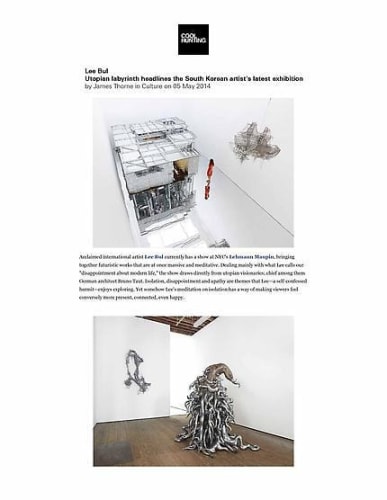
Lee Bul
Utopian labyrinth headlines the South Korean artist's latest exhibition
By James Thorne
Acclaimed international artist Lee Bul currently has a show at NYC's Lehmann Maupin, bringing together futuristic works that are at once massive and meditative. Dealing mainly with what Lee calls our "disappointment about modern life," the show draws directly from utopian visionaries; chief among them German architect Bruno Taut. Isolation, disappointment and apathy are themes that Lee—a self-confessed hermit—enjoys exploring. Yet somehow Lee's meditation on isolation has a way of making viewers feel conversely more present, connected, even happy.
The front of the gallery displays early works from Lee, making this a sort of small-scale retrospective. "Monster: Black" (1998) questions notions of biotechnology and the singularity through tentacles that worm out of a robust trunk, which is made mechanical through the use of reflective materials. Compare this with the architectural focus of the more recent works and viewers find a clear shift from the individual to a broader focus on society.
Moving to the rear section of the room, it would be easy to miss "Untitled" (2014), a sculpture that hangs suspended over a mirrored floor. A sort of futuristic landscape, the piece looks at first glance like a riot of beads and crystal. Here we see Lee's futurist obsession hard at work in a landscape that reflects Bruno Taut's utopian drawings from "Alpine Architecture" (1917).
But the real treat from the South Korean artist comes in the form of a mirrored labyrinth called "Via Negativa II" (2014), an immersive room within the rear gallery space. Lee sees the piece as a challenge to the automatic reaction people have when facing their own reflection. "When you walk into the labyrinth, there are so many of you—it's almost too reflective," she says. "This is to bother your automatic processes."
The pursuit of perfection is flawed, Lee seems to be saying, and at the same time it's worthwhile. In "Via Negativa II"—which translates to "The Negative Way II"—the idea is that we cannot say what divinity is, but we can say what it is not. As Lee explains, the mirrors have no characteristics: "Physically how they don't have any unique form or color—that's very interesting for me." In this way, the mirror proves to be the perfect material for describing the indescribable.
Full of fanciful notions about our pursuit of the ideal, Lee's work is still essentially down to earth. "I have questions about the destiny of humanity. I have interest in how humans can keep a positive vision of the future—these are conceptual ideas, but I want to create an experience."
